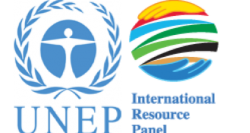Resource Efficiency & Climate Change
Resource efficiency, the material-related counterpart of energy efficiency, is a core strategy for manufacturing businesses to stay competitive, for national economies to reduce import dependency and create value from closing material cycles, and for reducing negative environmental impacts associated with the primary production of materials. The potential contribution of resource efficiency to climate change mitigation has only recently come into focus and is not well understood (Milford et al. 2013. Vuuren et al. 2018).
The Group of Seven (G7) member countries requested that the International Resource Panel conduct an assessment of the potential contribution of Resource Efficiency to Climate Change mitigation (RECC).
Resource Efficiency (RE) has been shown to be an effective means to reduce environmental impacts. In a previous report the International Resource Panel investigated the overall potentials and implications of resource efficiency (UNEP 2017) and found that RE could reduce natural resource use globally by 28% and greenhouse gas emissions by up to 20% in 2050, compared to a reference scenario.
Approach / Objective
The objective of this assessment is to highlight synergies between material resources conservation and greenhouse gas (GHG) abatement at the global scale. The project intends to quantify the potential future GHG abatement that can be achieved through the deployment of resource efficiency strategies at different levels. In particular the project will investigate six core material efficiency strategies (Allwood et al. 2012):
- More intense use
- Light-weighting
- Lifetime extension
- Re-use
- Fabrication scrap reduction
- Fabrication scrap diversion
Method
To analyze resource efficiency (RE) potentials, a representation of the socio-economic system will be modeled. The focus lies on main sectors, such as buildings, transport, consumer goods, etc. The model combines a ‘bottom-up’ analysis of identified RE measures and technologies with upscaling in a prospective scenario approach. The calculation of benefits will be based on the concept of avoided burden compared to the primary production of resources, but at a larger scale than individual applications at the unit level. The assessment will include the following elements:
- Categorization and mapping of RE policies
- Dynamic stock-flow model of materials (major metals, cement, plastics, wood products)
- Description and life cycle assessment of RE strategies and technologies for major material and product groups
- Development and modelling of counterfactual RE scenarios
- Quantification of life-cycle RE benefits
- Identification of major leverage points in the system, estimation of their mitigation potential, and recommendations for institutional reform and international coordination of RE
- Detailed, bottom-up knowledge about specific RE strategies
- Discussion of the interaction of RE and climate policies and an analysis of economic aspects and consequences of RE
Expected Results
The newly developed models are state-of-the-art socio-economic assessment models and will be made available open-source and published in scientific journals throughout the project. One key model element is the Open DYnamic Material flow model (ODYM) framework. It is a library for dynamic material flow analysis (MFA) and will be used for the overall project model. An early version of the model is already available on Github.
The overall model will also be made available at a later stage on Github (https://github.com/YaleCIE/RECC). Apart from the ODYM component, further modules are being developed:
- Scenario forecast model
- Sector models (buildings, transport, etc.)
- Life-cycle assessment
Team
Project lead: Prof. Edgar Hertwich, Director of the Center for Industrial Ecology, Yale University
Coordination: Dr. Niko Heeren, Yale University, USA (niko.heeren@yale.edu)
Core assessment team
- Prof. Saleem Ali, University of Delaware, USA
- Dr. Tomer Fishman, Yale University, USA
- Prof. Eric Masanet, Northwestern University, USA
- Dr. Farnaz Nojavan Asghari, Yale University, USA
- Prof. Elsa Olivetti, MIT, USA
- Ass.-Prof. Stefan Pauliuk, Freiburg University, Germany
- Dr. Qingshi Tu, Yale University, USA
Contributors and advisors
- Dr. Fulvio Ardente, Joint Research Center, European Commission
- Dr. Luca Ciacci, Bologna University, Italy
- Dr. Samuel Cooper, Bath University, United Kingdom
- Dr. Jonathan Cullen, Cambridge University, UK
- Prof. Matt Eckelman, Northeastern University, USA
- Prof. Thomas Graedel, Yale University, USA
- Prof. Stefanie Hellweg, ETH Zürich, Switzerland
- Prof. Rakhyun Kim, Utrecht University, Netherlands
- Reid Lifset, Yale University, USA
- Prof. Kazuyo Matsubae, Tohoku University, Japan
- Dr. Nabil Nasr, Rochester Institute of Technology, USA
- Prof. Bruno Oberle, Ecole Polytechnique de Lausanne, Switzerland
- Dr. Anne Owen, Leeds University, United Kingdom
- Prof. Heinz Schandl, Commonwealth Scientific and Industrial Research Organisation (CSIRO), Australia
- Prof. Ester van der Voet, Leiden University, Netherlands
- Prof. Helga Weisz, PIK, Germany
- Prof. Junming Zhu, Tsinghua University, China
Funding
Funding for the coordination of the project is provided by Italy. The work is largely a volunteer effort and most contributors are funded by their home institutions or through their individual research grants.
References
- Milford, R.L., S. Pauliuk, J.M. Allwood, and D.B. Müller. 2013. The Roles of Energy and Material Efficiency in Meeting Steel Industry CO 2 Targets. Environmental Science & Technology 47(7): 3455–3462. http://pubs.acs.org/doi/10.1021/es3031424.
- Vuuren, D.P. van, E. Stehfest, D.E.H.J. Gernaat, M. van den Berg, D.L. Bijl, H.S. de Boer, V. Daioglou, et al. 2018. Alternative pathways to the 1.5 °C target reduce the need for negative emission technologies. Nature Climate Change: 1. http://www.nature.com/articles/s41558-018-0119-8.
- UNEP. 2016. Resource Efficiency: Potential and Economic Implications. Paul Ekins, N. Hughes, S. Bringezu, C.A. Clarke, M. Fischer-Kowalski, T. Graedel, M. Hajer, et al. www.unep.org/resourcepanel.
- Allwood, J.M., M.F. Ashby, T.G. Gutowski, and E. Worrell. 2011. Material efficiency: A white paper. Resources, Conservation and Recycling 55(3): 362–381. http://dx.doi.org/10.1016/j.resconrec.2010.11.002.
- Allwood, C.J.M., H. Kong, and N. Pole. 2012. Sustainable Materials With Both Open Eyes. New York. www.withbotheyesopen.com/pdftransponder.php?c=100.
